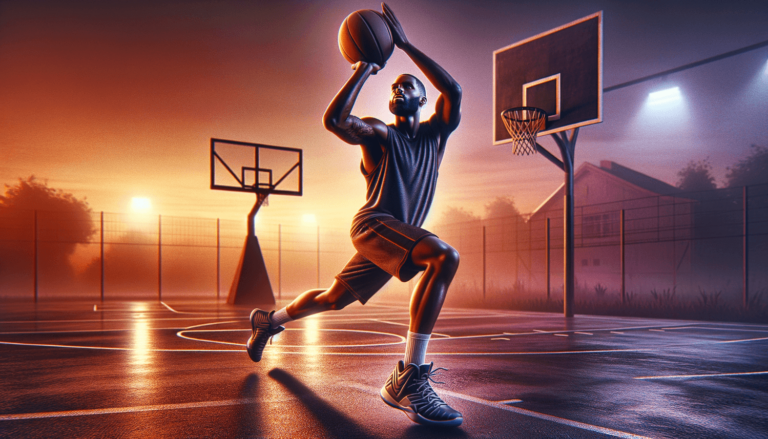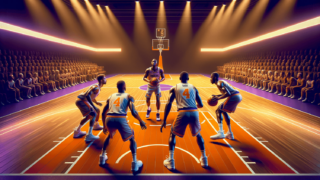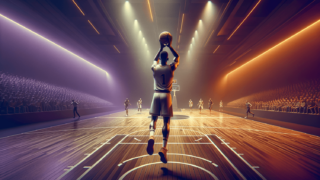
How to Be a Better Free Throw Shooter in Basketball?
Written by: Basketball Universe
Last updated:

Attention all basketball enthusiasts, one and all! Your journey to becoming an ace at the charity stripe starts now. Welcome to our comprehensive guide on ‘How to Be a Better Free Throw Shooter in Basketball,’ the ultimate toolkit for honing your skills from the line. Perfect for shooters of all levels, our engaging and fact-filled blog post will add a dash of professionalism and excitement to your free throw shooting. So, lace up your sneakers, visualize the ball swishing through the net, and let’s get ready to step up to that foul line like never before!
How to Be a Better Free Throw Shooter in Basketball?
To become a better free throw shooter in basketball, follow these key steps: 1) Maintain a consistent pre-shot routine, 2) Practice proper shooting form by aligning your body, focusing on the backspin, and extending the shooting arm, 3) Develop a strong mental game, including visualization and positive self-talk, 4) Regularly practice free throws under various conditions, and 5) Analyze your performance and make adjustments as needed.
Step 1: Establish a Consistent Pre-Shot Routine
One of the vital aspects of mastering free throw shooting is developing a consistent pre-shot routine. This ritual helps players relax, focus, and concentrate on their shot. Walk through these steps to create a consistent routine:
Positioning and Mindset
Position yourself at the free throw line, facing the hoop with your feet shoulder-width apart. Make sure your dominant foot is slightly in front of your non-dominant foot. Visualize yourself sinking the free throw and take a few deep breaths to calm your nerves and instill a positive mindset.
Repeating Key Motions
Repetition is the key to successful free throw shooting. This can include elements like dribbling a few times or spinning the basketball in your hands. Whatever action appeals to you, repeat it every time you step up to the free throw line. Consistent repetition of these motions creates muscle memory that contributes to your overall shooting success.
Step 2: Develop Proper Shooting Form
To become a more successful free throw shooter, it’s crucial to adhere to the fundamentals of proper shooting form. Here are some key elements of this:
Body Alignment
Ensure that your body is correctly aligned with the basket. Your feet, hips, and shoulders should all face forward, while your elbow and knees should be bent at the proper angles. Keep your dominant hand under the basketball, with your non-dominant hand supporting the ball on the side. You should have your eyes focused on the target at all times.
Applying Backspin
Proper backspin applied to the basketball can help to increase your shot accuracy. To do this, release the ball with your shooting hand’s fingertips, making sure that your wrist is snapping downward. This downward motion generates a backspin that helps stabilize the basketball’s trajectory towards the hoop.
Extend Your Shooting Arm
As you move into your shooting motion, make sure to fully extend your shooting arm, keeping your elbow in line with the basket. Follow through with your hand, ensuring that your fingers are pointed toward the hoop after releasing the basketball.
Step 3: Hone Your Mental Game
An often overlooked aspect of free throw shooting is the mental game. Cultivating a strong mindset can make a significant difference in your free throw shooting success. Consider incorporating the following mental techniques:
Visualization
Before you step up to the line, visualize yourself making the free throw. Focus on the ball going through the hoop, swishing the net, and imagine the cheers from the crowd. Doing this will help instill confidence in your ability to make the shot.
Positive Self-Talk
Engage in positive self-talk to remind yourself about the countless hours of practice spent perfecting your shot. Affirmations like “I’ve trained for this,” or “I can make this shot,” help to reinforce your belief in your shooting ability.
Step 4: Incorporate Regular Practice
Improving your free throw shooting requires consistent practice. Schedule regular sessions to work on your shot and simulate real game conditions. Use these practice tips to make your training sessions more effective:
Vary Your Practice Conditions
Vary the conditions of your practice, mixing in both high-pressure and low-pressure situations. Doing so will prepare you for the variety of scenarios you’ll face during actual games. For high-pressure practice, recruit a friend to simulate game noise, have someone counting down the shot clock, or practice with teammates, where a missed shot might require everyone to do push-ups.
Set Practice Goals
Establish practice goals that will help measure your progress and keep you motivated. Start by setting a daily target like attempting 100 free throws or shooting until you make 10 in a row. Track your progress over time and make adjustments to your goals based on your improvement.
Step 5: Analyze Your Performance and Adjust Accordingly
A crucial aspect of becoming a better free throw shooter is to analyze your performance and make adjustments as needed. Keep progressing with these evaluation techniques:
Review Game Footage
If you have access to game footage, study your free throw shooting performance in actual games. Pay close attention to your shooting form and pre-shot routine – make note of any inconsistencies or areas for improvement.
Feedback From Others
Ask your coaches, teammates, or fellow basketball enthusiasts for feedback on your free throw shooting. They might notice areas for improvement that you might not be aware of, which can help identify aspects of your form or technique that need adjustment.
Implement Changes
Based on your review and feedback, make changes to your technique, pre-shot routine, or mental exercises. Incorporate these adjustments into your practice sessions and diligently work on these areas until improvements are made.
By following these steps and committing to regular practice, you’ll be well on your way to becoming a better free throw shooter in basketball. Remember, every shooter’s journey is different, so embrace the process, learn from every experience, and have fun as you watch your game reach new heights!
Additional Tips for Improving Free Throw Shooting
As you continue to work on your free throw shooting, consider these supplementary tips and exercises to fine-tune your skills further and make you a more efficient, dynamic player on the court:
Strengthen Your Shooting Arm
Developing the muscles involved in shooting will help you maintain a consistent shooting form and control the basketball during the release. Incorporate strength training exercises into your workout routine, such as tricep dips, bicep curls, and push-ups, to build the muscles in your shooting arm.
Fine-Tune Your Grip
Ensure that your grip on the basketball is neither too tight nor too loose. A relaxed grip with your fingertips spread across the ball can help maintain control during the shot. Experiment with different grips during practice to determine which one allows for the most consistent release and backspin.
Master the Art of Breathing
Proper breathing techniques can help calm your nerves and improve focus during high-pressure free throw situations. Practice inhaling deeply as you receive the basketball and exhaling slowly while you go through your pre-shot routine. As you shoot, release your breath right before you release the ball. This will help you maintain a calm and steady mindset during your shot.
Embrace Competitive Scenarios
Engage in competitive free throw shooting games and contests with friends or teammates. This can create an enjoyable, high-pressure environment that mimics real game scenarios, helping you learn how to perform under pressure while simultaneously refining your free throw shooting.
Study Professional Shooters
Take the time to watch professional basketball players during their free throw attempts. Observe their pre-shot routine, body alignment, shooting mechanics, and follow-through. Emulate their techniques and adapt them to fit your unique shooting style.
By incorporating these additional tips and suggestions into your training regimen, you can continue to sharpen your skills and elevate your free throw shooting performance. Always remember that consistency, dedication, and a positive attitude are essential aspects of growth and success in basketball.
FAQ: Free Throw Shooting in Basketball
In this section, we address the most frequently asked questions about free throw shooting in basketball. Gain valuable insights and tips to enhance your performance from the foul line and become a more dependable shooter on the court:
1. How important are free throws in basketball games?
Free throws play a significant role in basketball games since they often determine the outcome of close matches. Converting free throws consistently can turn close games in your favor, rack up points for your team, and put pressure on your opponents.
2. How can I increase my free throw shooting percentage?
Increasing your free throw shooting percentage involves developing a consistent pre-shot routine, practicing proper shooting form, honing your mental game, engaging in regular practice, and analyzing your performance for opportunities to improve.
3. How can I stay calm during pressure free throw situations?
To stay calm during high-pressure free throws, focus on your breathing, visualize success, engage in positive self-talk, and rely on your consistent pre-shot routine to help you ease your nerves and concentrate on your shot.
4. How can I build confidence in my free throw shooting?
Building confidence in your free throw shooting involves developing a solid pre-shot routine, practicing consistently, setting attainable goals, visualizing successful shots, and utilizing positive self-talk to reinforce your belief in your skills.
5. How can I practice free throw shooting at home without a basket?
Without a basket, focus on practicing your pre-shot routine, shooting form, and strengthening the muscles involved in shooting. Utilize visualization techniques to imagine the ball swishing through the net, and work on grip, footwork, and alignment.
6. How much practice should I do each week for free throws?
The amount of practice varies for each individual, but ideally, you should aim for at least three to four practice sessions a week. Vary the intensity and conditions of your practice to simulate real game situations and maintain consistency.
7. What is the role of the non-dominant hand during a free throw?
The non-dominant hand serves as a guide or support during free throw shooting. It helps in controlling the basketball, ensuring proper alignment of the shot, and ensuring stability during the release.
8. How should I position my feet at the free throw line?
When positioning your feet at the free throw line, have them shoulder-width apart with your dominant foot slightly in front of your non-dominant foot. This stance provides balance and stability during the shot.
9. Which muscle groups should I focus on strengthening to improve my free throw shooting?
Focus on strengthening your shooting arm’s muscles, including the triceps, biceps, and shoulders. Additionally, work on your core and leg muscles to improve overall balance, stability, and power during your shot.
10. How can I maintain focus and concentration during free throw attempts?
Maintaining focus and concentration during free throw attempts involves developing a consistent pre-shot routine, keeping your eyes on the target, practicing proper breathing techniques, and using visualization and positive self-talk to reinforce confidence in your ability.
Featured Posts
- No pillar pages found.





